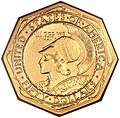Wikipedia:Today's featured article/June 15, 2015
The five Panama–Pacific commemorative coins ($50 piece pictured) were produced in connection with the 1915 Panama–Pacific International Exposition in San Francisco. Struck at that city's mint, the issue included round and octagonal $50 pieces. Excepting modern bullion coins, these two gold pieces are the highest denomination ever issued and the largest coins ever struck by the United States Mint. The octagonal $50 piece is the only non-round U.S. coin ever issued. In January 1915, Congress passed legislation for a silver half dollar, as well as a gold dollar, a quarter eagle ($2.50 piece), and the two $50 pieces. The Mint had already consulted artists, but Treasury Secretary William G. McAdoo initially rejected all their designs. Two of them persevered, Robert I. Aitken for the $50 pieces and Charles Keck for the gold dollar, and their submissions were used. The half dollar and quarter eagle were designed by Chief Engraver Charles E. Barber, possibly with the participation of his longtime assistant, George T. Morgan. The coins did not sell well, and many of each denomination were returned for melting. Only a few hundred of each of the $50 pieces were distributed, making them the lowest-mintage commemorative coins. They catalog for up to $200,000, depending on condition. (Full article...)

